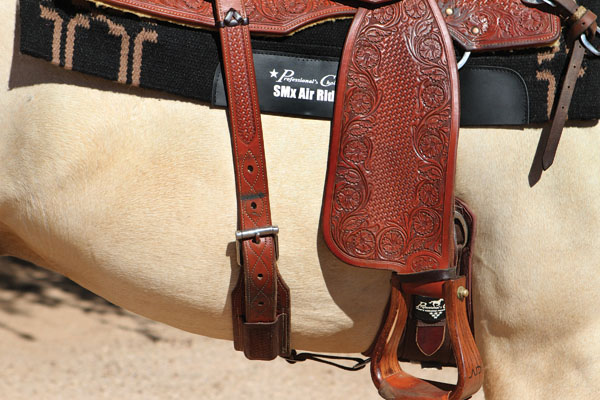The back, or flank, cinch is more than a decorative accessory for a Western saddle. It’s a safety piece that stabilizes the saddle by attaching with aid of rear billets and a leather hobble strap to the front cinch. The back cinch holds your saddle snug and level to your horse’s barrel, alleviating pressure to his withers because the saddle doesn’t shift forward during maneuvers. Because it’s unlikely your saddle will shift in certain show events, such as Western pleasure or horsemanship, a back cinch isn’t commonplace in these classes. But for hilly trail riding, cattle and speed events, reining, and other activities, a back cinch is a must.
[RELATED: TOP WESTERN FRONT CINCHES]

Choose a back cinch with features that’ll best suit your riding needs, then learn proper fit and care here so you can maximize the piece’s function.
Materials
The back cinch is made of leather and is available in single- or two-ply thicknesses. The thickness desired depends on personal preference and riding type.
The rear cinch billets are available in leather and poly material. While poly is more affordable up front, it doesn’t have the look or longevity of leather. The connecting back-cinch hobble is usually made of latigo leather.
Fit
The back cinch is meant to fit snugly against your horse’s belly, not hang inches beneath him where he could easily catch a foot. As with the front cinch, adjust the back cinch evenly on either side of your saddle so that the center of it aligns with the center of his belly. The back-cinch connector strap, or hobble, is a good indicator of proper adjustment. It should connect straight from the back cinch to the rear front-cinch dee. Tighten the connecting hobble so that the cinch aligns slightly forward of vertical, where there’s no risk of it sliding back to your horse’s flanks.
The length and width of your cinch should be appropriate for your horse’s size. Make sure it’s long enough that it can easily be adjusted to align vertically with your front cinch, or midway up his side. The cinch shouldn’t be so long that, when adjusted, the buckles meet your saddle pad. Though width is largely based on personal preference, your back cinch shouldn’t be so wide as to inhibit movement or to be irritating.
If your horse hasn’t worn a back cinch before or is ultra sensitive, you’ll have to get him accustomed to the close adjustment. Gradually tighten the back cinch closer to his belly until he’s used to the contact of the cinch. If necessary, make an adjustment then lead him in circles and repeat until properly fitted.
Styles
Your preferred riding activity will dictate which back-cinch style is most appropriate for your needs.
Straight. This style is best suited to riders who experience saddle tilt, but don’t put much torque on the saddle. Examples include trail riding, cow horse, reining, and cow sorting events. Straight back cinches are available in varied widths, from 1 to 5 inches, in quarter- and half-inch increments.
Tapered or roper-style. Whether you compete in roping or work on a ranch, this style is best to maximize security and safety. The tapered cinch, available in straight or contoured variations, provides greater surface-area contact with your horse’s underside to keep your saddle from tilting up in the back, even against the torque of a jerking steer dallied to the saddle horn. This style is typically wider, and available in widths exceeding 5 inches in half-inch increments.
Care
The underside, and especially the middle of your horse where the back cinch sits, is the sweatiest region of your horse’s body. This makes proper back-cinch care and upkeep imperative. If your horse sweats excessively or if you’ve collected sand, dirt, grass, or brush during your ride, you’ll need to clean the cinch before storing. Minimal grime might only require a quick brushing from a soft-bristle brush or hand towel. For excessive wear, use saddle soap and a towel for a full cleaning. Regularly oil your back cinch to keep it pliable and prevent cracking.
[RELATED: WESTERN SADDLE PAD ADVICE]

Diligent maintenance will ensure that your cinch lasts; a well-cared-for cinch can outlive your saddle. Cracking and stretched holes are the most common wear-and-tear issues. Check your tack before you mount to avoid wrecks under saddle. Replace gear if it’s irreparable, especially if your cinch appears to be cracked and splitting.
Al Dunning, Scottsdale, Arizona, has produced world champion horses and riders in multiple disciplines. He’s been a professional trainer for more than 40 years, and his expertise has led him to produce books, DVDs, and his own online mentoring program, Team AD International (teamadinternational.com).






